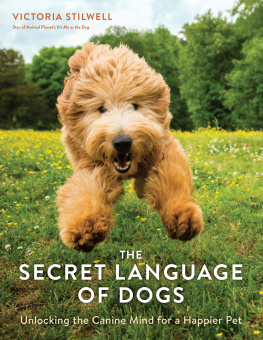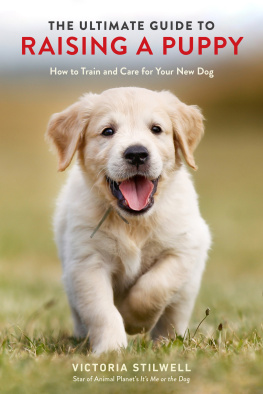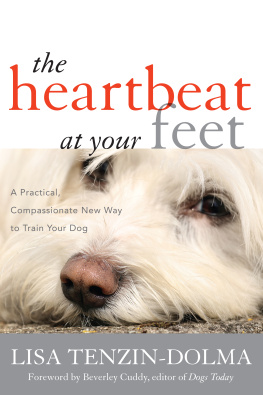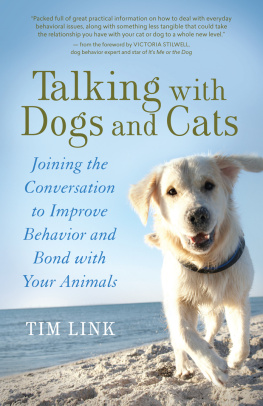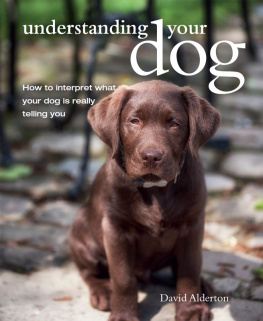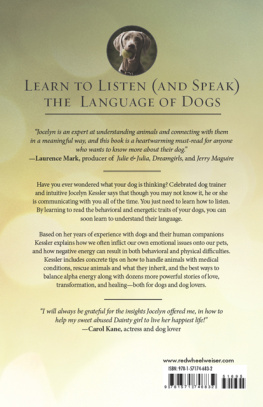ENDNOTES
INTRODUCTION
.
Bonne Beerda et al., Behavioural, Saliva Cortisol and Heart Rate Responses to Different Types of Stimuli in Dogs, Applied Animal Behaviour Science 58, no. 34 (July 1998): 365381.
Meghan Herron et al., Survey of the Use and Outcome of Confrontational and Non-confrontational Methods in Client-Owned Dogs Showing Undesired Behaviors, Applied Animal Behaviour Science 117, no. 12 (February 2009): 4754.
CHAPTER ONE: THE LOVING DOG
dm Miklsi and Jzsef Topl, What Does It Take to Become Best Friends? Evolutionary Changes in Canine Social Competence, Trends in Cognitive Sciences 17, no. 6 (June 2013): 287294.
.
Anna Herndia et al., Intranasally Administered Oxytocin Affects How Dogs (Canis familiaris) React to the Threatening Approach of Their Owner and an Unfamiliar Experimenter, Behavioural Processes 119 (October 2015): 15, doi:10.1016/j.beproc.2015.07.001.
Yomayra F. Guzmn et al., Fear-Enhancing Effects of Septal Oxytocin Receptors, Nature Neuroscience 16, no. 9 (September 2013): 11851187, doi:10.1038/nn.3465.
Department of Ethology, Lornd Etvs University, Attachment Behavior in Dogs, Journal of Comparative Psychology 112, no. 3 (October 1998): 219229.
CHAPTER TWO: THE THINKING DOG
Brian Hare and Vanessa Woods, The Genius of Dogs (New York: Plume, 2013).
Ibid.
Stanley Coren, How Dogs Think (New York: Free Press, 2004).
Claudia Fugazza, Do As I Do (Wenatchee, WA: Dogwise Publishing, 2014).
Temple Grandin, Animals in Translation (New York: Harcourt Books, 2005).
Kun Guo et al., Left Gaze Bias in Humans, Rhesus Monkeys and Domestic Dogs, Animal Cognition 12, no. 3 (May 2009): 409418.
.
.
CHAPTER THREE: THE EMOTIONAL DOG
Dr. Attila Andics et al. Voice Sensitive Regions in the Dog and Human Brain Are Revealed by Comparative fMRI, 24, no. 5 Current Biology (March 2014): 574578.
Alexandra Horowitz, Inside of a Dog (New York: Simon and Schuster, 2009).
CHAPTER FOUR: THE SENSING DOG
Jay Neitz, Timothy Geist, and Gerald H. Jacobs, Color Vision in the Dog, Visual Neuroscience 3 (1989): 119125.
Paul E. Miller and Christopher J. Murphy, Vision in Dogs, Leading Edge of Medicine, JAVMA 207, no. 12 (December 15, 1995): 16231634.
Ibid.
Ibid.
John W. S. Bradshaw, The Evolutionary Basis for the Feeding Behavior of Domestic Dogs (Canis familiaris) and Domestic Cats (Felis catus), Journal of Nutrition 136, no. 7 (July 2006): 1927519315.
Ibid.
Stephen R. Lindsay, Handbook of Applied Dog Behavior and Training, Adaptation, and Learning (New York: Wiley, 2013).
George M. Strain, Deafness in Dogs and Cats (Cambridge, MA: CABI, 2011).
Linn Mari Storengen and Frode Lingaas, Noise Sensitivity in 17 Dog Breeds: Prevalence, Breed Risk and Correlation with Fear in Other Situations, Applied Animal Behaviour Science 171 (October 2015): 152160.
Ibid.
A. S. Ahl, The Role of Vibrissae in Behavior: A Status Review, Veterinary Research Communications 10, no. 1 (December 1986): 245268.
CHAPTER FIVE: LATERAL LANGUAGE
Lara S. Batt et al., The Relationships Between Motor Lateralization, Salivary Cortisol Concentrations and Behavior in Dogs, Journal of Veterinary Behavior 4, no. 6 (November 2009): 216222; L. A. Schneider, P. H. Delfabbro, and N. R. Burns, Temperament and Lateralization in the Domestic Dog (Canis familiaris), Journal of Veterinary Behavior: Clinical Applications and Research 8, no. 3 (MayJune 2013): 124134.
Batt et al., The Relationships (2009).
.
A. Quaranta, M. Siniscalchi, and G. Vallortigara, Asymmetric Tail-Wagging Responses by Dogs to Different Emotive Stimuli, Current Biology 17, no. 6 (March 2007): R199201.
Marcello Siniscalchi, Angelo Quaranta, and Lesley J. Rogers, Hemispheric Specialization in Dogs for Processing Different Acoustic Stimuli, PLoS ONE (October 9, 2008): e3349, doi:10.1371/journal.pone.0003349.
Batt et al., The Relationships (2009).
.
CHAPTER SEVEN: THE LANGUAGE OF FEAR
N. H. Kalin et al., The Primate Amyygdala Mediates Acute Fear and Not the Behavioral and Physiological Components of Anxious Temperament, Journal of Neuroscience 21, no. 6 (March 15, 2001): 20672074.
Temple Grandin, Animals in Translation: Using the Mysteries of Autism to Decode Animal Behavior (New York: Scribner, 2005).
CHAPTER EIGHT: THE LANGUAGE OF AGGRESSION
James O. Heare, Aggressive Behavior in Dogs (Ottawa: DogPsych Publishing, 2007).
CHAPTER NINE: THE LANGUAGE OF VOCALIZATION
T. I. Raglus, B. D. Groef, and L. C. Marston, Can Bark Counter Collars and Owner Surveys Help Identify Factors That Relate to Nuisance Barking? A Pilot Study, Journal of Veterinary Behavior 10 (May 2015): 204209.
CHAPTER TEN: THE LANGUAGE OF PAIN
.
Louise Swindlehurst, 10 Ways Dogs Show They Have Muscular Pain and Its Relationship with Behaviour (lecture, Victoria Stilwell Dog Bite and Behaviour Conference, University of Lincoln, UK, June 2015).
.
B. Hothersall et al., Development of New Techniques to Assess Pain in Domestic Chickens. Paper presented at the UFAW Animal Welfare Conference, York, UK, June 30, 2010.
CHAPTER ELEVEN: THE LANGUAGE OF AGING
H. E. Salvin et al., The Canine Cognitive Dysfunction Rating Scale (CCDR), Veterinary Journal 188, no. 3 (2011): 331336.
.
CHAPTER TWELVE: STRANGE BEHAVIOR EXPLAINED
K. L. Overall and A. E. Dunham, Clinical Features and Outcome in Dogs and Cats with Obsessive-Compulsive Disorder: 126 Cases (19892000), Journal of the American Veterinary Medical Association 221, no. 10 (November 15, 2002): 14451452, doi:10.2460/javma.2002.221.1445.
Katriina Tiira et al., Environmental Effects on Compulsive Tail Chasing in Dogs, PLOS ONE 7.7 (July 26, 2012): e41684, doi:10.1371/journal.pone.0041684.
J. L. Rapoport, D. H. Ryland, and M. Kriete, Drug Treatment of Canine Acral Lick: An Animal Model of Obsessive-Compulsive Disorder, Archives of General Psychiatry 49, no. 7 (1992): 517521, doi:10.1001/archpsyc.1992.01820070011002.
.
K. Louie and M. A. Wilson, Temporally Structured Replay of Awake Hippocampal Ensemble Activity During Rapid Eye Movement Sleep, Neuron 29, no. 1 (January 2001): 145156.
.
Joseph L. Kirschvink, Earthquake Prediction by Animals: Evolution and Sensory Perception, Bulletin of the Seismological Society of America 90, no. 2 (April 2000): 312323.
Donal McKeown, Andrew Luescher, and Mary Machum, Coprophagia: Food for Thought, Canadian Veterinary Journal 29, no. 10 (October 1988): 849850.
CHAPTER THIRTEEN: HOW TO SPEAK DOG
Dr. John W. Pilley Jr., Chaser: Unlocking the Genius of the Dog Who Knows a Thousand Words (New York: Houghton Mifflin Harcourt, 2013).
Victoria Ratcliffe and David Reby, Orienting Asymmetries in Dogs Responses to Different Communicatory Components of Human Speech, Current Biology 24, no. 24 (December 2014): 29082912.
Nicholas H. Dodman et. al., Comparison of Personality Inventories of Owners of Dogs with and without Behavior Problems, International Journal of Applied Research 2, no. 1 (2004): 5561; A. L. Podberscek and J. A. Serpell, Aggressive Behaviour in English Cocker Spaniels and the Personality of Their Owners, Veterinary Record 141 (1997): 7376.

